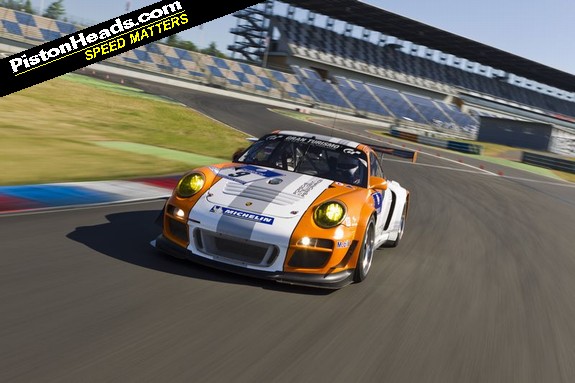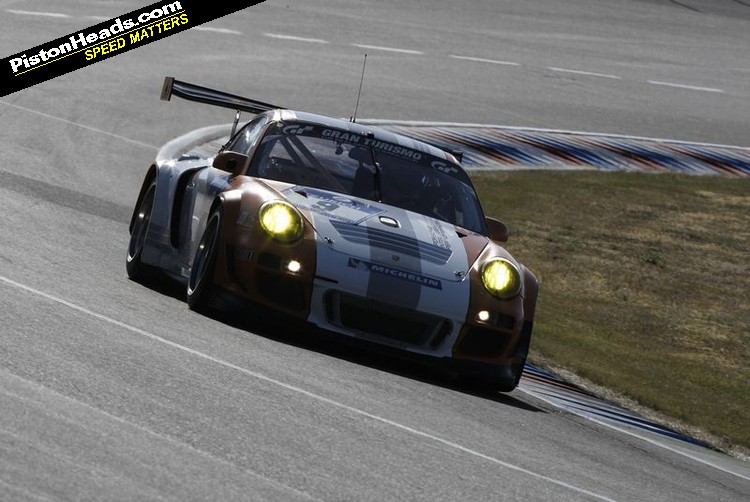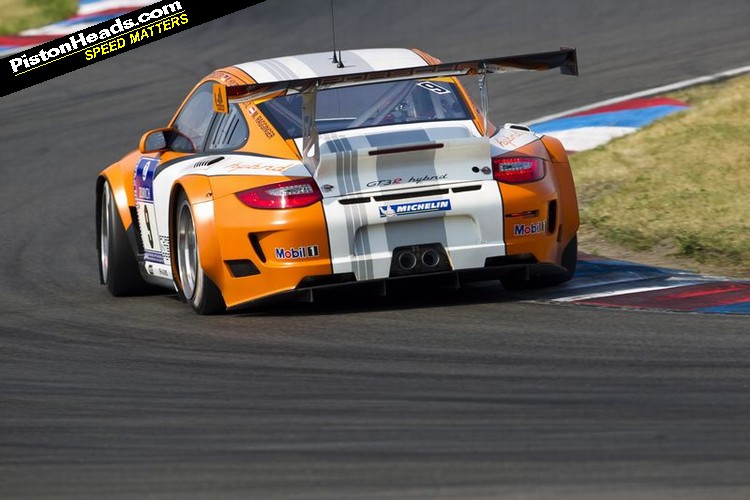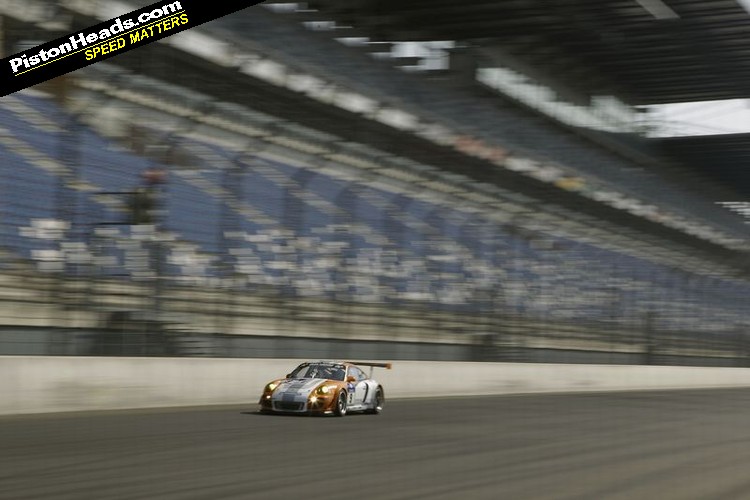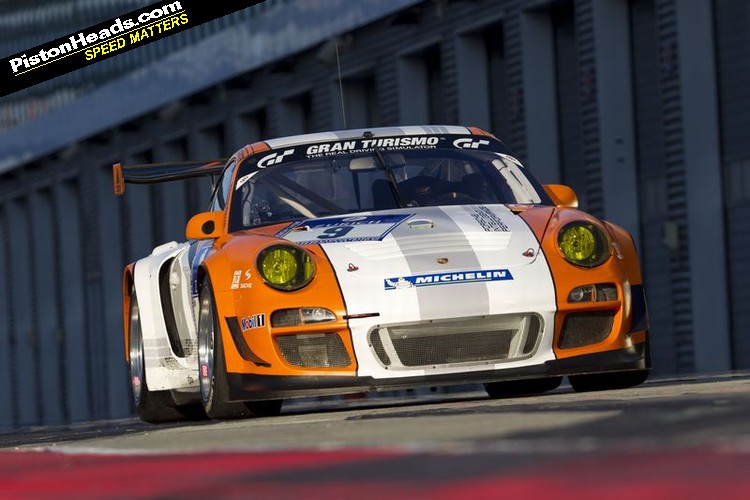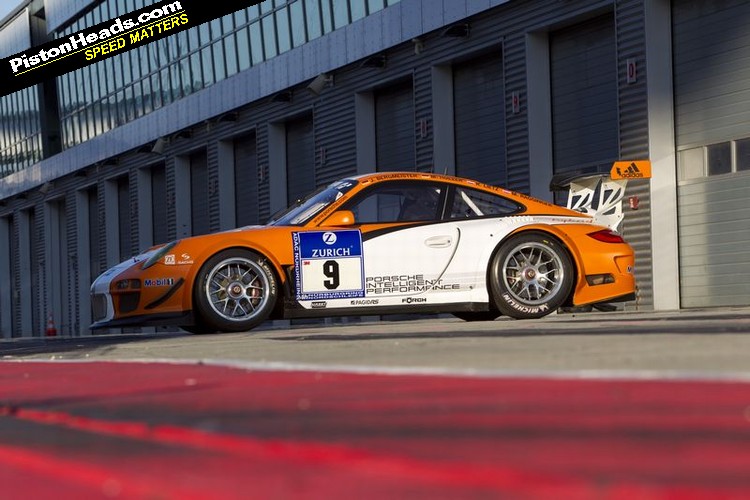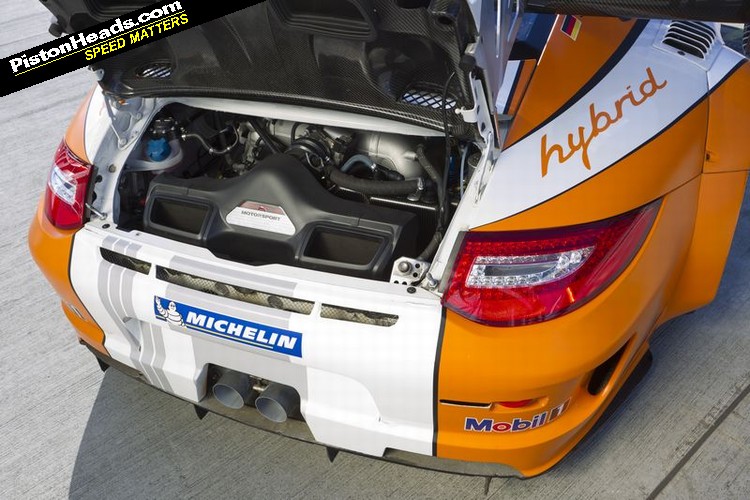2010 Porsche 911 GT3 R Hybrid - First Drive by Inside Line...
“This Hybrid Does Speed”

(Inside Line, 1 July 2010)
It's all about the little paddle. The titanium trinket that nestles behind the steering wheel unleashes an extra 160 horsepower and spits the 2010 Porsche 911 GT3 R Hybrid down the straightaway. It's like having a turbo, except that it deploys its boost instantly, exactly when you want it. This is a hybrid of the like we've never before experienced and it's absolutely sensational.
We come out of a tight 2nd-gear left-hander that leads up on to the banking of this American-style oval track. It's adverse camber and the car bogs a little as the rear tires struggle to hook up. Tweak that little titanium paddle and a wallop of torque ignites the front tires. There's a wiggle of protest through the steering wheel and then the car just picks up and flies. Six seconds of boost later and we're in 5th gear at 150 mph.
This is the Lausitzring, an extravagant oval track and infield road course 100 miles south of Berlin. Built for Indy-style cars, it's been seven years since the American open-wheelers last raced here, leaving the place to the Audis and Mercedes-Benzes of the DTM. Today, there are just two Porsche transporters and an orange-and-white racing car that is, of all things, a gas-electric hybrid.
The 2010 Porsche 911 GT3 R Hybrid led the legendary Nürburgring 24-hour race just this last May until the 22nd hour, when a valve spring threw a strop. This car is Porsche's test bed for hybrid technology, the only one of its kind in the world. Eventually it will no doubt take its place in Porsche's much-vaunted museum, unless something goes horribly wrong today. As we reach for our helmet, we're well aware that if we stick it in the wall, we'll be writing our own, infamous footnote in Porsche's history.
Science Experiment
What makes this particular Porsche 911 so special is not the bit at the back, because plonked behind the rear axle is the same 473-hp 4.0-liter flat-6 that you'll find in a standard GT3 R racecar. Instead the clever bit sits beside the driver. Nestled where the passenger seat ought to be is a cylindrical box that looks like it might have been pinched from a washing machine. This hides a flywheel capable of spinning to 40,000 rpm and storing energy as mechanical rotational energy.
The system was developed by the Williams Formula 1 team in 2008 in response to new regulations allowing the use of KERS (kinetic energy recovery systems). While other teams — notably Ferrari and McLaren — produced more traditional battery-based hybrid systems, Williams developed the flywheel concept, although it was never actually raced. With KERS banned in F1 for 2010 (it returns next year), Williams needed an outlet for its work, prompting an unlikely alliance with Porsche.
"Williams built the flywheel and inverter," says Hartmut Kristen, head of Porsche motorsport, "but this is a custom-tailored solution for Porsche. We needed to engineer a higher duty cycle because in Formula 1 you can only use the boost once a lap, but in a sports car you use it as much as possible. We also wanted more power, 120 kilowatts instead of 60." The flywheel is used to power two electric motors in the nose that are connected to the front wheels. When it's fully charged, you can enjoy maximum boost for around 6-8 seconds.
When you brake, the two electric motors reverse their role and act as generators, recharging the flywheel, almost as if you were driving a 180-mph Prius. "A flywheel solution has a key advantage compared with a battery," says Kristen. "With a battery-based solution, you can't collect all the energy because to do so would overpower and destroy the batteries. You only collect a small amount of what's available. But with a flywheel solution, that problem ceases to exist."
While the system is inherently mechanical, computers still play a key role. For maximum attack, the electric motors can be used to supplement the gasoline engine, delivering an extra 160 hp. But for endurance racing, they can also be used to boost fuel economy. In the Nürburgring 24, the Porsche team effectively detuned the GT3 R's gasoline engine so that it ran lean, relying on the assistance of the electric motors to provide performance equivalent to a normal GT3 R. The net result proved to be a 25 percent improvement in cruising range and a commanding race on the track.
The Racing Connection
The cockpit of the 2010 Porsche 911 GT3 R Hybrid is pure racing car. Only the sweep of the dashboard suggests any connection to the GT3 road car, while a thicket of toggle switches on the center console hint at this car's complexity. The instrument display is all digital, the steering wheel incorporates buttons for the radio and stability control, and a giant lever for the sequential manual transmission is at your side.
And it's hot; very hot. It's about 80 degrees Fahrenheit outside, but we're in full helmet and fire suit and salty sweat is already seeping into our eyes. Little wonder that Porsche's pro drivers always look like they need a good steak. Speaking of which, Patrick Long, the American who drives for Porsche's factory sports car teams, has flown in to try the car. "Be positive with the gearbox," he explains. "You don't need to use the clutch or lift off to shift up, but dip the clutch to shift down." Pull back firmly for 1st, dial up a snarl of revs and exit the pits.
It takes time to charge the flywheel motor, so the out lap is gasoline-engine only. Now the hybrid makes like a standard GT3 R, except for weight distribution shifted more to the front and a higher center of gravity. The sporting regulations for the Nürburgring 24 and the extra hardware also mean the hybrid weighs 276 pounds more than the standard GT3 RS car. It feels it. You never need reminding that this is a sports car with an engine in its bum, not an ultra-agile open-wheeler.
Hybrid Power on Line
As we negotiate the Lausitzring's infield road course, it's clear this car needs caressing. Roll off the brakes and tease the throttle. Feel the car take a neutral set midcorner and then get all squirmy again on the exit. Be brutal and it'll hit back with a quick jab of oversteer. So immediate are the signals that it's actually not hard to catch, although the line between hero and zero is still measured in microns.
The brakes need a determined shove and at first we're much too cautious. The regenerative hybrid system acts as a secondary brake system, snaffling the energy away and complementing the familiar feel of the discs. An antilock system is standard, made necessary by the regenerative system. "Because the system switches itself on and off, it would be extremely difficult to manage their performance without the electronics," says Kristen. Patrick Long bluntly adds, "You just stand on it and let the ABS do the hard work."
Another gizmo automatically blips the throttle during downshifts so there's no need to heel-and-toe. To us this just feels like cheating. If racing cars are made easier to drive, then the world's finest drivers suddenly look a tad less heroic.
Jörg Bergmeister, the Porsche factory driver who's driven more laps in the hybrid than anyone else, admits, "It's probably the easiest Porsche racecar to drive." Bergmeister also offered a few tips about exploiting the extra performance: "It's not just for the straights. Because it powers the front wheels, you can really use it to pull you out of corners. In the wet in particular, that's a really big advantage."
The trick, apparently, is to pull the paddle that triggers the motors just as the car starts to oversteer. Pull it too early and you could end up with an unwanted dollop of understeer. This will take time to perfect, but even after a couple of laps, it starts to make sense. The hybrid system isn't just a glorified "push-to-pass" button; it's a tactical weapon to be used with skill and judgment.
The feeling is not dissimilar to driving a Mitsubishi Evo on the limit, when you sense the diffs start to distribute the power. Except that in the Porsche, the shift of emphasis is controlled by the middle finger of your left hand. Extend that digit and the computers go to work, measuring your throttle angle and steering input and then deciding how many of the 160 horses to set free. For a one-off test bed conceived in January 2009, this car is extraordinarily well developed.
Coming to a Porsche Store Near You?
While hybrid technology has by and large been devoted to improving fuel economy, Porsche's flywheel system could be the right kind of technology for high-performance cars, perhaps even the forthcoming 998 version of the 911 that Porsche is expected to introduce next year. "A push-to-pass function would be brilliant," admits Kristen.
But there's a stumbling block and it lies in the way in which governments measure fuel consumption. The efficiency benefits of a hybrid like the 2010 Porsche 911 GT3 R Hybrid would not be reflected in its fuel economy ratings. Indeed, because this hybrid is heavier than the conventional street-legal version, the figures would actually be worse. A hybrid car that is, on the face of it, less efficient than the standard alternative would be difficult to sell, both politically and commercially.
The other issue is cost. This concept is worth well over a million dollars, or around three times as much as a standard GT3 R. Porsche's army of gentleman racers are rich, but they're not that rich.
Science Is Fun
The 2010 Porsche 911 GT3 R Hybrid is an intoxicating companion. We're having so much fun that we miss the pit board marked "In." Then we miss it again, prompting a handful of engineers to climb the guard fence and wave frantically in our direction. Feeling pretty sheepish, we pull back into the pits and park the prototype racer.
Driving any 911 on a racing circuit is always a treat, but this car brings with it an extra frisson of excitement. This comes not just from a natural interest in the nascent technology, but from what it offers you as a driver. The 911 GT3 R Hybrid takes the classic 911 formula and adds an extra layer of interest. Let's hope that the GT3 R Hybrid really is a pointer to the supercar of tomorrow, because if it is, that future will be brighter than any of us dared imagine.
Specification & Performance
Vehicle
Year Make Model: 2010 Porsche 911 GT3 R Hybrid 2dr Coupe (4.0L gas-electric hybrid)
Vehicle Type: RWD two-door, two-passenger coupe
Estimated MSRP: n/a
Assembly location: Stuttgart, Germany
Drivetrain
Configuration: Longitudinal, rear-engine combined with electric motor(s), rear-wheel drive
Engine type: Naturally aspirated, port-injected gasoline flat-6
Displacement (cc/cu-in): 3,996cc (244 cu-in)
Block/head material: Aluminum/aluminum
Valvetrain: DOHC, four valves per cylinder
Compression ratio: 12.2
Horsepower (hp @ rpm): 473 @ 7,250
Torque (lb-ft @ rpm): 352 (est.)
Fuel type: Premium unleaded (required)
Hybrid type: Parallel, with two permanent magnet synchronous motors
Electric motor rating (kW): 60 kW x 2; 80 Nm x 2
Combined horsepower (hp @ rpm): 633 hp @ 7,250rpm
Combined torque (lb-ft @ rpm): 470 lb-ft
Battery type: Electric flywheel
Battery capacity, usable (kW-hr): 0.2
Transmission type: Six-speed manual with console shifter
Transmission ratios (x:1): I=3.154; II=2.294; III=1.850; IV=1.552; VI=1.097
Final-drive ratio (x:1): 2.889
Differential(s): Limited-slip (37 percent)
Chassis
Suspension, front: Independent MacPherson struts with dual lower ball joints, coil springs, monotube dampers, stabilizer bar
Suspension, rear: Independent multilink, coil springs, monotube dampers, stabilizer bar
Steering type: Speed-proportional power steering
Tire make and model: Michelin
Tire type: Performance front - performance rear
Tire size, front: 27/65R18
Tire size, rear: 31/71R18
Wheel size, front: 18-by-11 inches
Wheel size, rear: 18-by-13 inches
Wheel material: Forged aluminum
Brakes, front: 15-inch ventilated steel discs with 6-piston fixed calipers
Brakes, rear: 14-inch ventilated steel discs with 4-piston fixed calipers
Fuel Consumption
Fuel tank capacity (US gal.): 26.4
Dimensions & Capacities
Curb weight, mfr. claim (lbs.): 2,921
Length (in.): 175.7
Width (in.): 77.0
Height (in.): 50.4
Wheelbase (in.): 93.2
Turning circle (ft.): 35.7
Seating capacity: 1



























Porsche-911-GT3-R-Hybrid_Inside-line_First-Drive























